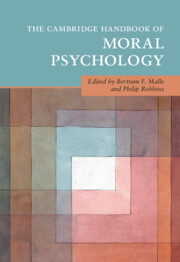Book contents
- The Cambridge Handbook of Moral Psychology
- Cambridge Handbooks in Psychology
- The Cambridge Handbook of Moral Psychology
- Copyright page
- Contents
- Figures
- Tables
- Contributors
- Preface
- 1 Modern Moral Psychology
- Part I Building Blocks
- 2 Moral Character
- 3 Moral Motivation
- 4 Norms: Inference and Interventions
- 5 Moral Dilemmas
- 6 The Moral Domain
- Part II Thinking and Feeling
- Part III Behavior
- Part IV Origins, Development, and Variation
- Part V Applications and Extensions
- Index
- References
6 - The Moral Domain
What Is Wrong, What Is Right, and How Your Mind Knows the Difference
from Part I - Building Blocks
Published online by Cambridge University Press: 20 February 2025
- The Cambridge Handbook of Moral Psychology
- Cambridge Handbooks in Psychology
- The Cambridge Handbook of Moral Psychology
- Copyright page
- Contents
- Figures
- Tables
- Contributors
- Preface
- 1 Modern Moral Psychology
- Part I Building Blocks
- 2 Moral Character
- 3 Moral Motivation
- 4 Norms: Inference and Interventions
- 5 Moral Dilemmas
- 6 The Moral Domain
- Part II Thinking and Feeling
- Part III Behavior
- Part IV Origins, Development, and Variation
- Part V Applications and Extensions
- Index
- References
Summary
This chapter of the handbook tackles a foundational question in moral psychology: What constitutes the moral domain? To answer this question, we first have to know how our minds determine right from wrong. The authors argue that our intuitive, culturally flexible perceptions of harm drive our judgments of the moral domain. This is not the dominant view of the moral domain, but the most popular models of the past and present need not be the most accurate ones. Instead, these paradigms reflect broader shifts in our values as a society and a field of research. The Turielian moral domain of the 1970s and 1980s took inspiration from the cognitive revolution, positing harm as a universal value that fully determines how people decide right from wrong. The Haidtian paradigm of today is influenced by the rise of cross-cultural psychology, arguing that harm is just one of many intuitive, culturally activated moral values. Ultimately, neither paradigm gets it completely right, but the authors argue that we can build a better paradigm by combining the strengths of each. In this model, harm is the key driver of moral judgments, but perceptions of harm are intuitive and culturally variable.
- Type
- Chapter
- Information
- The Cambridge Handbook of Moral Psychology , pp. 124 - 150Publisher: Cambridge University PressPrint publication year: 2025

